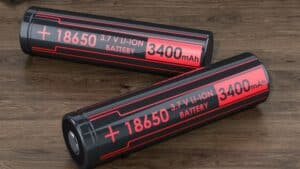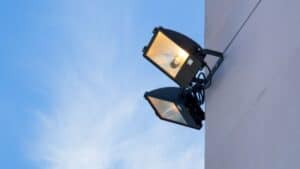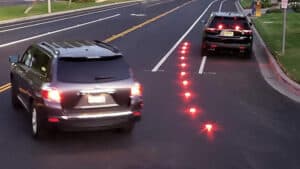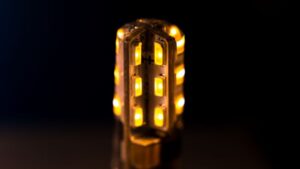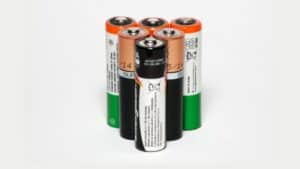Have you ever tried to find your keys in a wide, dark field with a tiny keychain light? Or maybe you’ve tried to read a map up close with a super-focused spotlight? It doesn’t work very well, does it? This shows why a single flashlight isn’t perfect for every job. The secret to a great flashlight isn’t just brightness; it’s the shape of its beam.
In this blog, we’ll talk about wide “flood” beams, long-reaching “throw” beams, and the handy beams that do a bit of both. By the end, you’ll know exactly what to look for to find the perfect flashlight for you.
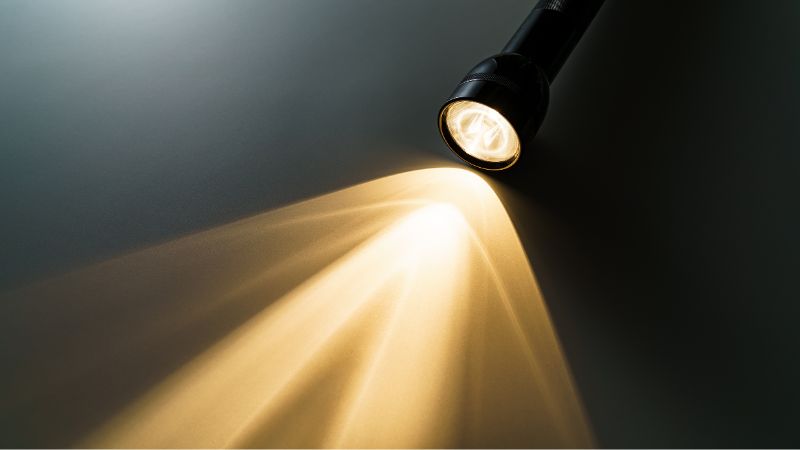
What is a Flashlight Beam Pattern?
Ever wonder how a flashlight creates its specific beam pattern? It’s not magic! It’s all about how a few key parts work together.
The Light Source (The Heart of the Flashlight): Almost all modern flashlights use LEDs (Light Emitting Diodes). Think of the LED as the heart of your flashlight. The type of LED affects how bright the light is and its color.
The Reflector (The Sculptor of Light): The reflector is the shiny, cone-shaped part around the LED. Its job is to gather all the light and send it forward. There are two main types:
- Smooth Reflector (SMO): A reflector with a mirror-like finish creates a tight, focused beam. This is what gives a flashlight a super-bright “hotspot” that can travel a long way.
- Orange Peel Reflector (OP): This reflector has a slightly bumpy texture, like the skin of an orange. This texture smooths out the light, creating a softer, more even beam with a less defined hotspot.
The Lens (The Final Touch): The clear glass or plastic at the front of the flashlight is the lens. It protects the reflector and LED. Some advanced flashlights use special TIR Lenses, which stand for Total Internal Reflection. These lenses are very efficient and can create all sorts of clean, precise beam patterns without needing a deep reflector.
The Three Main Types of Flashlight Beams
Flashlight beams generally fall into one of three categories.
1. The Flood Beam (Wide-Area Illumination)
- What it is: A flood beam is like turning on a lamp in a dark room. It spreads a wide, even circle of light that lights up a large area close to you. It’s great for seeing what’s around you, not just what’s straight ahead.
- Best for: Camping, hiking on a trail, working on your car, or finding something in your basement. It gives you great peripheral vision.
- Pros & Cons: The big advantage is excellent situational awareness. The downside is that it doesn’t reach very far.
2. The Throw Beam (Long-Distance Spotlight)
- What it is: A throw beam is the exact opposite of a flood. It’s a narrow, intense beam of light designed to be a spotlight, reaching hundreds of feet away.
- Best for: Search and rescue, boating, hunting, or any time you need to identify something far in the distance.
- Pros & Cons: You get incredible long-distance range, but the beam is so tight that you won’t see much to your left or right.
3. The Hybrid Beam (The Best of Both Worlds)
- What it is: Can’t decide between flood and throw? You don’t have to! A combined beam is the most common and versatile pattern. It features a bright central hotspot for distance (the “throw”) surrounded by a dimmer, wider ring of light called “spill” (the “flood”).
- Best for: Just about anything! It’s a fantastic all-purpose beam for tactical use, dog walking, or general exploring.
- Pros & Cons: It’s a great jack-of-all-trades. While it might not throw as far as a dedicated thrower or flood as wide as a dedicated flooder, it handles most tasks beautifully.
Beyond the Basics: Advanced Beam Features
Some flashlights have extra tricks up their sleeves.
- Adjustable Focus (Zoomable) Beams: These flashlights let you slide the head of the light forward or backward. This changes the distance between the lens and the LED, allowing you to “zoom” the beam from a wide flood to a tight throw.
- Beam Color and Tint: Not all white light is the same! “Cool white” light is crisp and blueish, while “warm white” is softer and yellowish. A warmer tint can be much better at cutting through fog, dust, or rain.
- Understanding Flashlight Metrics:
- Lumens: This is the most common number you see. It measures the total amount of light coming out of the flashlight. More lumens means a brighter light overall.
- Candela: This number tells you how intense the beam is at its brightest point. High candela means a long throw distance. A high-lumen light with low candela is a flooder; a high-candela light can have fewer lumens but be a great thrower.
- Special Beam Modes:
- Strobe Mode: This is a rapidly flashing light designed to disorient an attacker or to signal for help.
- UV (Ultraviolet) Beams: These specialty lights are used to check for counterfeit money, find pet stains, or in forensic work.
How to Choose the Right Flashlight Beam
So, which beam is right for you? It all depends on what you’ll be doing.
- For the Outdoor Enthusiast: A combined beam is your best friend. It gives you the distance to see down the trail and the flood to see what’s rustling in the bushes beside you. An adjustable focus light is also a great choice.
- For the Professional (Law Enforcement, Security): A powerful throw beam is essential. You need high candela to identify threats or investigate from a safe distance.
- For Everyday Use: A simple flood beam or a small combined beam is perfect for tasks around the house, in the garage, or keeping in your car’s glove box.
- For the Industrial Worker: A durable flashlight with a wide, reliable flood beam is best for lighting up your entire workspace without creating harsh hotspots.
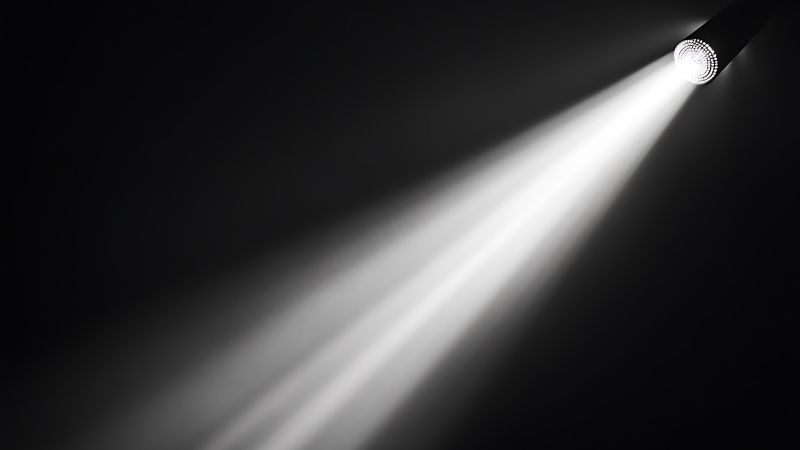
Finding Your Perfect Beam with MF Opto
Now that you’re an expert on the differences between flood, throw, and combined beams, you can see why having the right tool for the job is so important. At M&F Optoelectronics, we specialize in providing a wide range of high-quality lighting solutions designed to meet any need, ensuring you get the perfect beam every time.
For Wide-Area Flood Beams: If your tasks require broad, even illumination for close-quarters work, our collection of Portable Work Lights and Inspection Lamps are exactly what you need. They are designed to eliminate harsh hotspots and shadows, making them perfect for mechanics, construction sites, and any workshop application where situational awareness is key.
For Long-Distance Throw Beams: When you need to see hundreds of meters away, a powerful throw beam is essential. Our Handheld Spotlights are engineered for maximum candela and distance. These are the ideal tools for search and rescue, law enforcement, maritime navigation, or any activity where identifying objects far in the distance is critical.
For Versatile Hybrid Beams: For the ultimate jack-of-all-trades, a combined beam offers the best of both worlds. Many of our Flashlights feature a powerful central hotspot for throw, surrounded by a wide spill for flood. Some models even offer adjustable focus, allowing you to seamlessly transition between a tight spotlight and a wide beam, making them the perfect all-purpose tool for outdoor enthusiasts and everyday use.
Ready to Find Your Light? Don’t compromise on quality or performance. With over 15 years of experience, M&F Optoelectronics is your trusted partner for reliable and innovative lighting. Explore our full range of products to find the perfect flashlight for your needs.
Contact Us Today for a Free Quote and let our experts help you illuminate your world
Conclusion: Illuminate Your World with the Perfect Beam
As you can see, there’s a lot more to a flashlight than just turning it on. By understanding the difference between a wide flood, a long-reaching throw, and a versatile combined beam, you can make a much smarter choice.
Before you buy your next flashlight, think about what you’ll use it for most. Do you need to see what’s at the other end of the field, or just find your way around the campsite? Answering that question will lead you to the perfect beam to light up your world. Happy exploring
Frequently Asked Questions (FAQ)
1. What’s better: a floodlight beam or a throwlight beam?
Neither is “better”—it’s all about having the right tool for the right job! A flood beam is better for lighting up a wide area close to you, like a campsite. A throw beam is better for seeing things far away, like across a field or lake. For general use, a combined beam often gives the best balance of both.
2. Do more lumens mean a better flashlight?
Not always! Lumens measure total light output, but they don’t tell you how focused that light is. A 1000-lumen floodlight might only light up 50 feet in front of you, while a 1000-lumen thrower could light up something 1,000 feet away. You need to look at both lumens (for brightness) and candela (for distance) to understand how a flashlight will perform.
3. Can a single flashlight act as both a flood and throw light?
Yes, absolutely! There are two main ways this is achieved. First is a combined beam, which naturally has a tight hotspot for throw and wider spill for flood. Second is an adjustable focus (or “zoomable”) flashlight, where you can physically slide the head to change the beam from a wide circle to a tight square for maximum throw.
4. What beam is best for tactical or self-defense situations?
For self-defense, you want a flashlight with very high lumens and a strobe mode. The intense brightness can temporarily blind an attacker, and the strobe is extremely disorienting. A combined beam is ideal because the bright hotspot can be aimed at a threat, while the spill light helps you stay aware of your surroundings.
5. Are adjustable “zoom” flashlights a good choice?
They can be! Their biggest advantage is versatility, as you can switch from a wide flood to a tight throw. However, this feature often comes with trade-offs. Zoomable flashlights have more moving parts, making them less durable and harder to waterproof. The beam quality can also be less perfect than a fixed-focus flashlight designed for one specific job.


